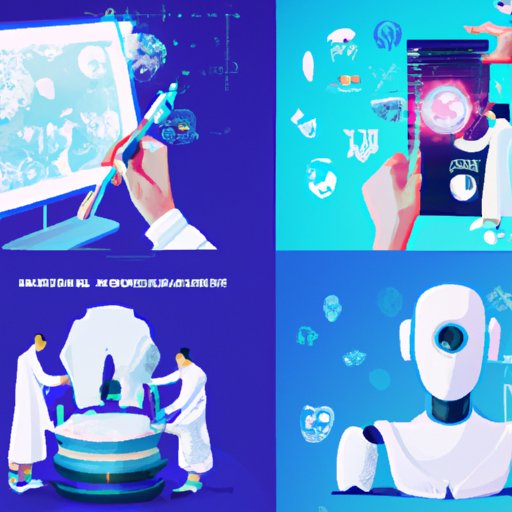Introduction
Artificial Intelligence (AI) is a rapidly developing field of computer science that enables machines to act and think like humans. AI has been around for decades, but with the advancement of technology, AI has become increasingly popular in many industries, including healthcare. AI is being used to improve healthcare services, from diagnostics and treatments to patient monitoring and drug development. In this article, we’ll explore where AI is used in healthcare and the benefits it brings.
Diagnostic Imaging & Radiology
Diagnostic imaging is an important part of modern medicine, enabling physicians to diagnose and treat patients. AI is used to help radiologists detect anomalies in images such as X-rays, CT scans, and MRIs. AI algorithms can recognize patterns in images and detect abnormalities that might be difficult for a human to spot. AI-based systems are also able to monitor changes in medical images over time, allowing for early detection of diseases and conditions.
The use of AI in diagnostic imaging and radiology has several benefits. AI algorithms can identify anomalies quickly and accurately, helping radiologists make informed decisions faster. AI can also reduce the workload of radiologists by flagging potential issues for further review. This allows radiologists to focus on more complex cases, leading to better patient care.
Telehealth & Remote Patient Monitoring
Telehealth is the use of technology to provide medical services remotely. AI is used in telehealth to assess patients’ symptoms and provide diagnoses. AI-based systems can analyze voice recordings, text messages, and images to identify signs of illness or disease. AI can also be used to track vital signs, such as heart rate and blood pressure, and alert doctors if there are any irregularities.
The use of AI in telehealth and remote patient monitoring has several benefits. AI-based systems can provide accurate diagnoses and treatment plans quickly, reducing wait times for patients. AI can also help doctors monitor patients remotely, providing real-time data on their health status. This can help doctors make informed decisions about the best course of action for each patient.
Robotics in Surgery
Robotics is being used more and more in surgical procedures. AI is used to assist surgeons during operations, helping them carry out complex tasks with precision. AI-based systems can provide surgeons with real-time data on a patient’s condition, enabling them to make informed decisions during surgery. AI can also be used to control robotic arms, enabling surgeons to perform complicated procedures with greater accuracy.
The use of AI in robotics surgery has several benefits. AI-based systems can help surgeons make better decisions during operations, reducing the risks associated with surgery. AI can also enable surgeons to perform complex procedures with greater accuracy and speed, leading to better outcomes for patients.
Wearable Health Monitors
Wearable health monitors are devices that can measure a person’s vital signs and activity levels. AI is used in these devices to collect and analyze data, providing insights into a person’s health. AI-based systems can detect anomalies in a person’s vital signs and alert them if there is a problem. AI can also be used to monitor a person’s activity levels, providing personalized feedback and advice to help them maintain a healthy lifestyle.
The use of AI in wearable health monitors has several benefits. AI-based systems can provide users with detailed information about their health, enabling them to make informed decisions about their lifestyle. AI can also alert users to potential problems before they become serious, allowing them to take action sooner.
Clinical Decision Support Systems
Clinical decision support systems are computer programs that help healthcare professionals make accurate diagnoses and treatment plans. AI is used in these systems to analyze a patient’s medical history, current symptoms, and laboratory results. AI-based systems can compare a patient’s data to a database of similar cases and suggest possible diagnoses and treatments.
The use of AI in clinical decision support systems has several benefits. AI-based systems can provide healthcare professionals with accurate and up-to-date information about a patient’s condition, enabling them to make informed decisions quickly. AI can also reduce the risk of errors, leading to better patient care.
Drug Development & Delivery
AI is being used to develop new drugs and deliver them more efficiently. AI-based systems can analyze large datasets to identify promising new compounds. AI can also be used to optimize drug delivery, ensuring that the right dose is delivered at the right time.
The use of AI in drug development and delivery has several benefits. AI-based systems can help researchers find new compounds quickly and accurately. AI can also automate drug delivery, ensuring that patients get the right dose at the right time.
AI-Powered Chatbots for Healthcare
AI-powered chatbots are computer programs that can interact with people in natural language. AI is used in these chatbots to understand a person’s questions and provide answers. AI-based chatbots can provide information about a patient’s symptoms and suggest possible diagnoses and treatments.
The use of AI in AI-powered chatbots for healthcare has several benefits. AI-based chatbots can provide accurate and up-to-date information about a patient’s condition, enabling them to make informed decisions quickly. AI can also reduce the workload of healthcare professionals, allowing them to focus on more complex cases.
Conclusion
AI is being used in a variety of ways in healthcare, from diagnostics and treatments to patient monitoring and drug development. AI is being used to improve diagnostic imaging and radiology, telehealth and remote patient monitoring, robotics surgery, wearable health monitors, clinical decision support systems, drug development and delivery, and AI-powered chatbots for healthcare. The use of AI in healthcare has several benefits, including improved accuracy, faster diagnosis and treatment, and reduced workload for healthcare professionals.
(Note: Is this article not meeting your expectations? Do you have knowledge or insights to share? Unlock new opportunities and expand your reach by joining our authors team. Click Registration to join us and share your expertise with our readers.)
